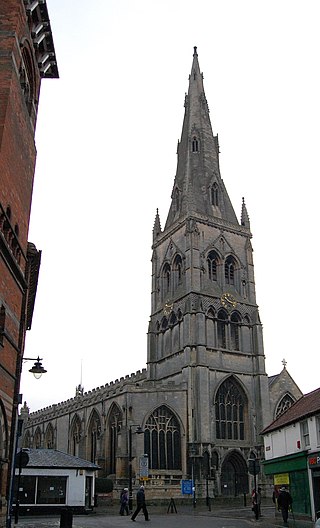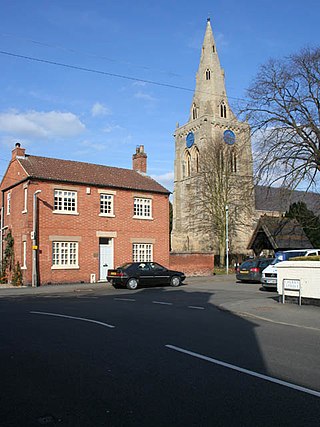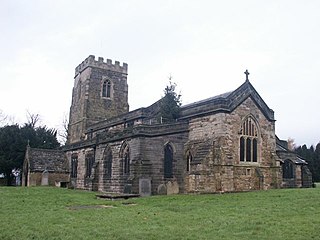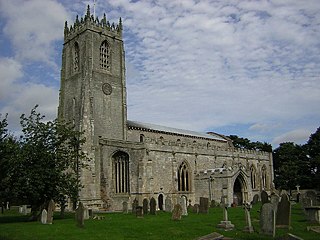
Newstead Abbey, in Nottinghamshire, England, was formerly an Augustinian priory. Converted to a domestic home following the Dissolution of the Monasteries, it is now best known as the ancestral home of Lord Byron.

Worksop Priory is a Church of England parish church and former priory in the town of Worksop, Nottinghamshire, part of the Diocese of Southwell and Nottingham and under the episcopal care of the Bishop of Beverley.

Thurgarton is a small village in rural Nottinghamshire, England. The village is close to Southwell, and Newark-on-Trent and still within commuting distance to Nottingham. It is served by Thurgarton railway station. According to the 2001 census it had a population of 412, increasing to 440 at the 2011 census and marginally to 445 at the 2021 census.

St. Botolph's Priory was a medieval house of Augustinian canons in Colchester, Essex, founded c. 1093. The priory had the distinction of being the first and leading Augustinian convent in England until its dissolution in 1536.

Fiskerton is a village and former civil parish, now in the parish of Fiskerton cum Morton, in the Newark and Sherwood district, in the county of Nottinghamshire, England. It is on the west bank of the River Trent about 3 miles southeast of Southwell. The waterfront is home to million-pound residential properties, previously residences of merchants and businessmen who commuted in the 1800s to nearby Nottingham by rail from Fiskerton Station. In 1881 the parish had a population of 283.

Shelford Priory is a former Augustinian Monastery located in the village of Shelford, Nottinghamshire, United Kingdom. The priory was founded by Ralph Haunselyn around 1160–80 and dissolved in 1536. Little remains of the original priory. Following dissolution it was granted to Michael Stanhope, and c.1600 Shelford Manor was constructed on the site. The manor was fortified and then partially destroyed during the English Civil War. The house was reconstructed c.1678, however, it was altered in the 18th and 19th centuries. It is now known as Shelford Manor and is a private residence.

Ulverscroft Priory is a former hermitage and priory in Ulverscroft, Leicestershire.

St Mary Magdalene Church, Newark-on-Trent is the parish church of Newark-on-Trent in Nottinghamshire, England. It is dedicated to Mary Magdalene and is the tallest structure in the town.

The Church of St. Mary and All Saints, Bingham, is the parish church of Bingham in the Rushcliffe borough of Nottinghamshire, England. The church, in the Diocese of Southwell and Nottingham is a Grade I listed building and this was given by the Department for Digital, Culture, Media and Sport as a building of outstanding architectural and historical interest.

St. Helen's Church, Selston is a parish church in the Church of England in Selston, Nottinghamshire.

The Church of St Editha is a Church of England parish church and Grade I listed building in Tamworth, Staffordshire, England.

St Osyth's Abbey was a house of Augustine Canons Regular in the parish of St Osyth in Essex, England in use from the 12th to 16th centuries. Founded by Richard de Belmeis, Bishop of London, c. 1121, it became one of the largest religious houses in Essex. It was dedicated to Saints Peter and Paul as well as St Osyth (Osith), a royal saint and virgin martyr. Bishop Richard obtained the arm bone of St Osyth from Aylesbury for the monastic church and granted the canons the parish church of St Osyth.

Kirby Bellars Priory was a small priory of Canons Regular of Saint Augustine in Leicestershire, England. It is now the Church of England Parish Church of Saint Peter's serving the village of Kirby Bellars.
St Katherine's Priory also known as The Priory of Saint Katherine without Lincoln was a Gilbertine priory of Canons Regular on the Fosse Way just outside the walls of Lincoln, England. The priory ran the Hospital of St Sepulchre, probably the first hospital in the city.

Blyth Priory was a priory in Nottinghamshire, England, dedicated to St Mary the Virgin.

Kersey Priory was a priory in Kersey, Suffolk, England. It was founded before 1218 as a hospital dedicated St Mary the Blessed Virgin and St Anthony under rule of Austin Canons. It was dissolved in 1443 and the next year transferred to King's College, Cambridge. Kersey Priory is a scheduled monument. The house on the site called "The Priory" became a Grade II listed building on 23 January 1958, part of the priory kitchen is said to be incorporated in the house.

The Church of St. Winifred is a church in Kingston on Soar, Nottinghamshire.

Felley Priory is a 16th century house with gardens located in the village of Felley, Nottinghamshire, UK. It is situated on the grounds of a former priory established by Augustinians in 1156 and dissolved in 1536. The gardens were started in 1974 by Maria Chaworth-Musters and opened to the public through the National Garden Scheme just two years later. Since Maria's passing in 2010, the gardens have been managed by her granddaughter and expert gardener, Michelle Upchurch. In 2021, the gardens were one of the four finalists in the public gardens category in NGS's The Nation's Favourite Gardens competition.



















